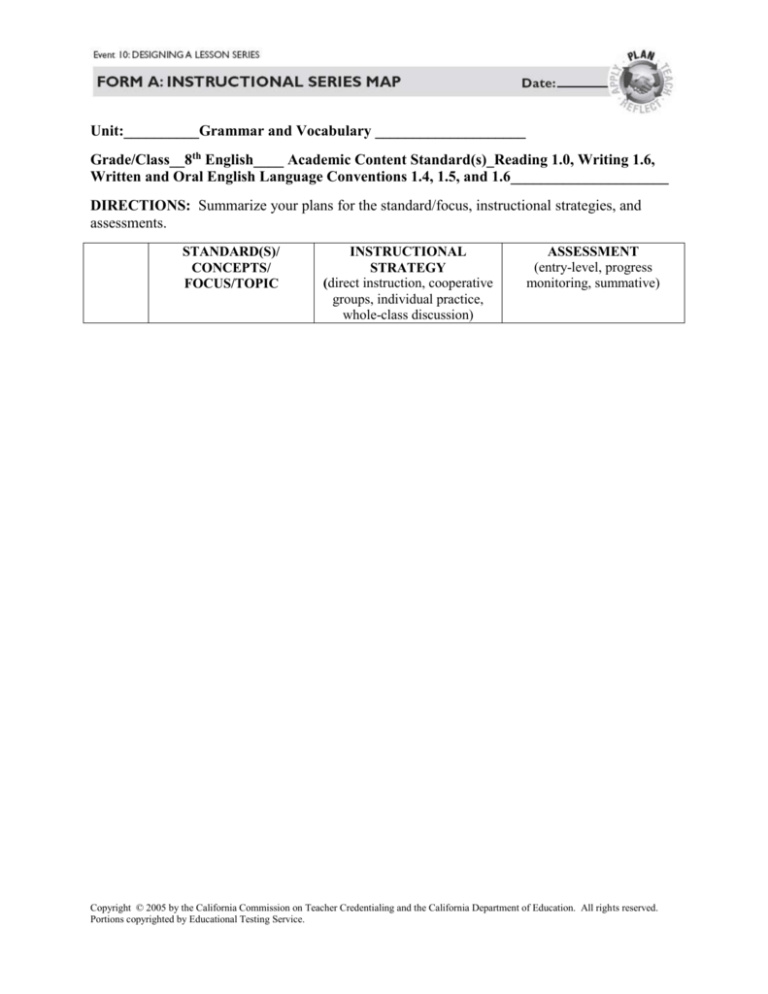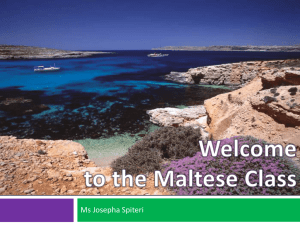
Unit:__________Grammar and Vocabulary ____________________
Grade/Class__8th English____ Academic Content Standard(s)_Reading 1.0, Writing 1.6,
Written and Oral English Language Conventions 1.4, 1.5, and 1.6_____________________
DIRECTIONS: Summarize your plans for the standard/focus, instructional strategies, and
assessments.
STANDARD(S)/
CONCEPTS/
FOCUS/TOPIC
INSTRUCTIONAL
STRATEGY
(direct instruction, cooperative
groups, individual practice,
whole-class discussion)
ASSESSMENT
(entry-level, progress
monitoring, summative)
Copyright © 2005 by the California Commission on Teacher Credentialing and the California Department of Education. All rights reserved.
Portions copyrighted by Educational Testing Service.
Expanding vocabulary
knowledge.
Direct Instruction
Whole- Class discussion
Recognizing different
parts of a sentence (noun,
verb, etc)
Editing written work for
grammar and spelling
errors.
Classwork assignments
collected and graded
Homework
Group Work (identifying
parts of sentences and editing
Vocabulary and grammar
a written work)
test
Individual Work (creating
sentence using vocabulary
words, editing a written
work, and practicing
grammar)
Individually edited
written work
LESSON PLAN
Individual online interactive
program warm-up
Copyright © 2005 by the California Commission on Teacher Credentialing and the California Department of Education. All rights reserved.
Portions copyrighted by Educational Testing Service.
DIRECTIONS: Identify the critical understandings and skills for the selected content
standard(s) which you would expect students to have prior to the lesson series you are planning.
Identify prior experiences students may have had with the standard(s).
What prerequisite skills, concepts and knowledge will students need in order to meet the
standard(s)? Information sources include classroom assessment, district assessment, and CAT6
(grades 3,7,10), STAR (grades 2-11), and CELDT.
Class:
Students have basic grammar knowledge (i.e. definition of a noun, verb, etc.), student know
how to construct proper sentences, students know how to work together cooperatively, and
students have basic note taking and test taking skills.
English learners:
Students have some grammar knowledge, students know how to construct a sentence,
students know how to work together cooperatively, and students have some note taking
and test taking skills.
MODIFICATIONS/ACCOMODATIONS:
English Language Learner:
Students receive extra handouts with grammar/vocabulary practice and instruction.
Special Education Student:
Students receive extra handouts with grammar/vocabulary practice and instruction.
Resources you might use:
Academic Content Standards/Framework
Teacher Resources – teacher’s guides, other instructional/support materials including Specially Designed Academic
Instruction in English (SDAIE) materials.
Student Resources – student texts, charts, rubrics, activity cards, exemplars, technology applications
District Curriculum Guides/ Course of Study
Observations and discussions with colleagues with subject-matter expertise and//or SDAIE experience and expertise
Copyright © 2005 by the California Commission on Teacher Credentialing and the California Department of Education. All rights reserved.
Portions copyrighted by Educational Testing Service.
DIRECTIONS: Complete one instructional plan for each lesson on Form A. If you use a
district lesson plan, copy and attach.
INSTRUCTION PLAN
K-12 Academic Content Standard(s):
REFLECTION
MODIFICATIONS/ACCOMODATIONS:
English Language Learner:
None.
What is the academic learning goal(s)?
Students are able to construct and recognize
a grammatically correct sentence.
Students are able to identity different part
of a sentence (verb, noun, adjective, etc.).
Students are able to create a sentence given
a vocabulary word.
Students are able edit a written work for
grammatical and spelling errors.
Special Education Student:
None.
Copyright © 2005 by the California Commission on Teacher Credentialing and the California Department of Education. All rights reserved.
Portions copyrighted by Educational Testing Service.
INSTRUCTION PLAN
What instructional strategies and activities
will you use for this lesson?
Class:
Students will have direct instruction, group
work, individual practice, and whole-class
discussions, because activity variety is
important.
Student will edit written works, work on
grammar handouts, take a test, do online
warm-ups, create sentences with vocabulary
words, and identity different parts of
sentences.
English Language Learner modifications:
Receive extra instructional and practice
handouts for grammar. Will be grouped
together with either other English Language
Learners or regular students to provide a
safe and productive learning environment.
REFLECTION
In what ways are your instructional strategies
and activities effective in measuring the
learning goals for this lesson?
Class:
The test and the homework/classwork
activities done in class shows the students
knowledge of the information. The students
have to apply their knowledge in editing and
identifying mistakes in another’s works.
Grammar and vocabulary handouts test the
students ability to apply their knowledge to
examples they had not previously
encountered.
English Language Learner:
Same.
Special Education Student:
Same.
Special Education Student modifications:
Same as above, except for groups would
consist of other Special Education students
or the patient knowledgeable regular
student.
Copyright © 2005 by the California Commission on Teacher Credentialing and the California Department of Education. All rights reserved.
Portions copyrighted by Educational Testing Service.
INSTRUCTIONAL PLAN
PROGRESS MONITORING ASSESSMENT
What evidence (student work) will you collect
during this lesson that will show the extent to
which students have achieved the learning
goal(s)?
Class:
Group work of editing and grammar
handouts.
REFLECTION
In what ways are your assessment strategies
effective in measuring the learning goals for
this lesson?
Class:
Effectively tests student knowledge of the
subject, because it forces them to apply the
information to various examples.
Individually edited written work.
Newly constructed student sentences using
vocabulary words.
English Language Learner:
Same.
Special Education Student:
Same.
English Language Learner modifications:
Same.
Special Education Student modifications:
Same.
How might you modify assessment of the
academic content standard(s)?
Class:
Academic content standards were the basis
of the lesson plan and creating these
activities.
English Language Learner:
Same.
Special Education Student:
Same.
Copyright © 2005 by the California Commission on Teacher Credentialing and the California Department of Education. All rights reserved.
Portions copyrighted by Educational Testing Service.
INSTRUCTIONAL PLAN
How will you group students for instruction
during this lesson? (based on reading level,
English learner level, etc.)?
Students would be grouped together based
on various skills levels, because that way
they could help each other.
How did you choose the group for English
Language Learner?
Paired based on equal skill level or ones
with high skill level to form a comfortable
learning environment.
REFLECTION
In what ways are these grouping(s) appropriate
for your students?
Class:
The high level student learns more from
teaching and the lower level students learn
more because they are practicing with their
peers.
English Language Learner:
Challenges them to learn more while being
comfortable in their group.
Special Education Student:
Same as above.
How did you choose the group for Special
Education Student?
Same as above.
In what ways are the materials and technology
effective?
What instructional materials and technology
will you use?
Grammar handouts, vocabulary handouts,
computer with internet access, paper, pen,
handouts for editing, and sentences
handout.
Class:
Materials all provided for the class by the
teacher, no books to carry, and all
information outlined for them.
English Language Learner modifications:
Same.
English Language Learner:
Same.
Special Education Student modifications:
Same.
Special Education Student:
Same.
Copyright © 2005 by the California Commission on Teacher Credentialing and the California Department of Education. All rights reserved.
Portions copyrighted by Educational Testing Service.
Copyright © 2005 by the California Commission on Teacher Credentialing and the California Department of Education. All rights reserved.
Portions copyrighted by Educational Testing Service.









